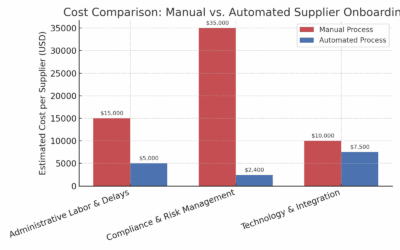Are you looking to create a more effective supplier offboarding process? As someone in the supplier risk management or procurement space, you know that offboarding is essential to your overall third-party risk management program.
But if your supplier offboarding process is inefficient or doesn’t create optimal value for your company, it can be time-consuming and costly. That’s why establishing and implementing a detailed supplier offboarding checklist is so important.
A good offboarding checklist enables you to quickly and efficiently handle the exit of suppliers that no longer meet your needs or requirements. In this blog post, we’ll provide tips on creating and using a supplier offboarding checklist for maximum efficiency and effectiveness.
What Is Supplier Offboarding?
Supplier offboarding is the process of disengaging from or discontinuing a business relationship with a supplier. Like onboarding, offboarding should involve an organized and structured plan to ensure the recovery of key data and information and the removal of the supplier from your company systems while minimizing any risk to your company. Creating a supplier offboarding checklist is a key part of this process and can help you keep track of tasks when it is time to part ways with a supplier.
The procedure for offboarding a supplier should include:
- Gathering all relevant documents for review
- Canceling any services and contracts in compliance with their terms
- Transferring project information, as applicable
- Enforcing vendor non-disclosure agreements, if applicable
- Establishing a return and recovery policy for any company property or equipment
- Updating internal knowledge repositories where necessary.
A checklist will help ensure all checkbox items related to a specific vendor are complete. It also helps reduce the time spent on manual communication with all stakeholders so you can focus on other tasks.
Why Is an Offboarding Checklist Important?
An offboarding checklist is an essential tool in the supplier risk management process. It helps you ensure that all necessary steps are taken when a supplier is terminated or their services are no longer needed.
By having an offboarding checklist in place, you can avoid potential legal and financial risks from incorrect or incomplete termination of a supplier. It also helps to maintain the integrity of your contractual agreements and reduces the risk of data leakage.
Using a checklist also reduces the possibility of business disruptions due to forgotten or overlooked steps in the offboarding process. By outlining each step in advance, a clear roadmap for execution can be established so that nothing gets overlooked.
Furthermore, having a well-defined offboarding process sets expectations with your entire team and eliminates ambiguity when it comes time to end the relationship with your suppliers. This helps to ensure that everyone is on board with the decision and is aware of their roles in the offboarding process.
What Should You Include in an Offboarding Checklist?
Let’s talk about what should go into your supplier offboarding checklist.
Internal Teams
When you onboard a new supplier, you likely worked with several internal teams like accounting and procurement to help with onboarding tasks. When it comes time to offboard, ensure that internal teams are notified. This can help you save time down the road by making sure everyone is on the same page.
Risk Mitigation
One of the main reasons for having a supplier offboarding process is risk mitigation. Include items like data protection or compliance-related tasks in your supplier offboarding checklist, such as a request for a Certificate of Insurance or a formal document confirming all data has been wiped from company systems.
Vendor Evaluation Follow-up
Don’t forget vendor evaluation follow-up! As with onboarding, you should include items in your supplier offboarding checklist that ask for feedback from the vendor about their experience working with your company and what could have been different. This type of feedback is helpful for both parties involved and can be used to improve overall supplier relations in the future.
Implementing Your Offboarding Checklist
When it comes to offboarding, following a checklist is helpful. Having a clear plan helps make the process easier and faster, which saves you a lot of time and headaches. Here are some tips for implementing your supplier offboarding checklist:
Have a Standard Overview
Your supplier offboarding checklist should include all the steps for a successful offboarding. Have a standard overview that outlines the processes to follow, including who will do what and when, who is responsible for ensuring tasks are complete, and what results are expected. A good overview will help you keep track of the entire process and ensure everything runs smoothly.
Communicate Clearly
It’s critical to communicate any changes or issues with the supplier in your offboarding process so nothing slips through the cracks. Ensure all involved know their roles and are aware of any updates or changes that could affect their responsibilities during the offboarding process.
Use Automation Tools
Automation tools such as document management systems can help streamline your offboarding process by eliminating repetitive manual tasks such as data entry and paperwork filing. Automated systems can also ensure that all documents are stored securely in one place, making it easier for you and your supplier to access them when needed.
These tips will help ensure that your supplier offboarding process runs smoothly and efficiently—and that your suppliers can leave knowing everything has been taken care of properly.
Tips for Successful Offboarding
You’ve done the hard work of finding a great supplier, onboarding them, and managing the relationship throughout the partnership. Now it’s time to part ways, and it’s crucial to do so in a way that protects your company from any risk. That’s where a supplier offboarding checklist comes in.
Creating a successful supplier offboarding checklist involves three main steps:
- Planning: Before you initiate offboarding, develop a plan that accounts for all potential risks associated with ending the partnership. The plan should include detailed steps on how to communicate with the supplier, and how to ensure all necessary documents are received and completed in an orderly fashion.
- Execution: Once the plan is in place, set up regular meetings between you and your supplier to ensure that all tasks are completed per your plan. Ensure you have received all relevant documents from your supplier before they leave your business network entirely.
- Follow-up: After the official termination date of the partnership with your supplier, follow up with them periodically to ensure no issues have arisen post-termination. This could involve checking for security breaches, ensuring final payments have cleared, or seeing if additional documents or statements are needed for auditing purposes.
By following these steps when creating and executing an offboarding checklist, you can help mitigate end-of-partnership risk. This allows you and your team peace of mind as you move on to new partnerships with other suppliers!
Leveraging Technology for Supplier Offboarding
Technology can be your best friend when it comes to supplier offboarding. With the help of automated offboarding processes, you can stay organized and ensure nothing slips through the cracks.
SupplierGateway’s Supplier Onboarding and Offboarding platform helps you manage the entire supplier lifecycle from onboarding to offboarding, so you can hit the ground running with an efficient, effective offboarding process. Here are some of its key features:
- Automated notifications when contracts or agreements are expiring
- Customizable spaces for supplier data and records
- Streamlined document management, from onboarding to contract renewal and termination
- Comprehensive audit trail of all actions taken on suppliers
- Automated review process to ensure adherence to compliance regulations
These features keep your team organized while ensuring everything runs according to plan—and that means a successful supplier offboarding process with minimal effort.
Conclusion
A supplier offboarding checklist is a must when managing the supplier offboarding process. The task of offboarding can be complex and tedious, but a well-crafted checklist can help reduce risk and ensure everything is taken care of properly.
With the right tools, like SupplierGateway’s SaaS supplier management platform, you can rest assured that your supplier offboarding process is efficient, secure, and compliant. Ultimately, the real win is identifying and managing supplier risk before, during, and after a supplier offboarding process, which helps you save time and money, reduce risk, and free up resources to focus on managing other areas of your business.
Request your demo today to start reducing your risk through supplier onboarding and offboarding.












